1、什么是webview
WebView是Android中的原生UI控件,主要用于在app应用中方便地访问远程网页或本地html资源。同时,WebView也在Android中充当Java代码和JS代码之间交互的桥梁。实际上,也可以将WebView看做一个功能最小化的浏览器。WebView这个控件又包含四大部分:WebSettings、WebViewClient、WebChromeClient、JavascriptInterface。通过四个类,我们可以为WebView设置基础功能和监听。
2、webview的基本使用
添加网络权限
在AndroidManifest.xml中添加以下内容
<uses-permission android:name="android.permission.INTERNET" />
添加layout的xml
<LinearLayout xmlns:android="http://schemas.android.com/apk/res/android"
android:layout_width="match_parent"
android:layout_height="match_parent">
<WebView
android:id="@+id/webview"
android:layout_width="match_parent"
android:layout_height="match_parent" />
</LinearLayout>
WebView一些常用的API,如加载url、前进后退、清理缓存、状态管理更新
// 加载url:
webView.loadUrl(url)
// 往请求头header增加参数
val hashMap: HashMap<String, String> = HashMap()
hashMap["name"] = "zhangsan"
webView.loadUrl(url, hashMap)
// 加载 HTML 页面的一小段内容
webView.loadData("", "text/html", "utf-8")
webView.loadDataWithBaseURL(null, "", "text/html", "utf-8", null)
// 后退、前进:
webView.canGoBack() //是否可以后退
webView.goBack() //后退一页面
webView.canGoForward() //是否可以前进
webView.goForward() //前进一页面
webView.goBackOrForward(-1) //后退或前进多少步,正前负退
//清除缓存数据:
// 清除网页访问留下的缓存,由于内核缓存是全局的因此这个方法不仅仅针对webview而是针对整个应用程序.
webView.clearCache(true)
// 清除当前webview访问的历史记录,只会webview访问历史记录里的所有记录除了当前访问记录.
webView.clearHistory()
// 这个api仅仅清除自动完成填充的表单数据,并不会清除WebView存储到本地的数据。
webView.clearFormData()
//WebView的状态
webView.onResume() // 可见状态
webView.onPause() // 页面失去焦点变成不可见状态
webView.pauseTimers() // 页面失去焦点变成不可见状态,对整个应用的webview起作用
webView.resumeTimers() //恢复pauseTimers时的动作
webView.destroy() //销毁
接下来进入到最基本的使用
webView = (WebView) findViewById(R.id.webview);
//加载网页链接
webView.loadUrl("https://www.baidu.com");
3、webview的WebSettings
WebSettings类的主要作用是为H5设置一些配置功能,如常用设置是否支持JSjavaScriptEnabled、设置缓存cacheMode。
webSetting = webView.settings
// 告诉WebView启用JavaScript执行。
webSetting?.javaScriptEnabled = true
//缓存
//缓存模式
webSetting?.cacheMode = WebSettings.LOAD_DEFAULT
// 开启 DOM storage API 功能
webSetting?.domStorageEnabled = true
//开启 database storage API 功能
webSetting?.databaseEnabled = true
//开启 Application Caches 功能,还需要设置路径
webSetting?.setAppCacheEnabled(true)
webSetting?.setAppCachePath("")
//设置WebView是否应使用其屏幕上的缩放控件和手势支持缩放。
//可以使用{@link #setBuiltInZoomControls}设置应使用的特定缩放机制。
//此设置不会影响使用{@link WebView#zoomIn()}和{@link WebView#zoomOut()}方法执行的缩放。默认值为{@code true}。
webSetting?.setSupportZoom(true)
//设置WebView是否应使用其内置的缩放机制。内置的缩放机制包括屏幕缩放控件(显示在WebView的内容上)以及使用捏合手势控制缩放。可以使用{@link #setDisplayZoomControls}设置是否显示这些屏幕上的控件。默认值为{@code false}
webSetting?.builtInZoomControls = false
// 是否支持ViewPort的meta tag属性,
// 如果页面有ViewPort meta tag 指定的宽度,则使用meta tag指定的值,否则默认使用宽屏的视图窗口
webSetting?.useWideViewPort = true
// 设置WebView是否以概述模式加载页面,即缩小内容以适合屏幕宽度。
// 当内容宽度大于WebView控件的宽度时,例如{@link #getUseWideViewPort} 已启用。默认值为{@code false}
webSetting?.loadWithOverviewMode = true
//设置渲染线程的优先级。与其他设置不同,此设置每个过程仅需要调用一次。默认值为{@link RenderPriority#NORMAL}。
webSetting?.setRenderPriority(WebSettings.RenderPriority.HIGH)
// 设置基础布局算法。这将导致WebView的重新布局。默认值为{@link LayoutAlgorithm#NARROW_COLUMNS}。
webSetting?.layoutAlgorithm = WebSettings.LayoutAlgorithm.NORMAL
//启用或禁用WebView中的文件访问。
//请注意,这仅启用或禁用文件系统访问。仍然可以使用file:/// android_asset和file:/// android_res访问资产和资源。
webSetting?.allowFileAccess = true
//告诉WebView在调用{@link WebView#requestFocus(int,android.graphics.Rect)}时是否需要将节点设置为具有焦点。默认值为{@code true}。
webSetting?.setNeedInitialFocus(true)
//告诉JavaScript自动打开窗口。
// 这适用于JavaScript函数{@code window.open()}。默认值为{@code false}
webSetting?.javaScriptCanOpenWindowsAutomatically = true
//支持自动加载图片
webSetting?.loadsImagesAutomatically = true
//设置解码html页面时使用的默认文本编码名称。 *默认值为“ UTF-8”。
webSetting?.defaultTextEncodingName = "utf-8"
// 设置默认字体大小。默认值为16。
webSetting?.defaultFontSize = 16
//设置最小字体大小。预设值为8。
webSetting?.minimumFontSize = 8
/**
* Webview在安卓5.0之前默认允许其加载混合网络协议内容
* 在安卓5.0之后,默认不允许加载http与https混合内容,需要设置webview允许其加载混合网络协议内容
*/
if (Build.VERSION.SDK_INT >= Build.VERSION_CODES.LOLLIPOP) {
webSetting?.mixedContentMode = WebSettings.MIXED_CONTENT_ALWAYS_ALLOW
}
//获取WebView是否支持多个窗口。
webSetting?.supportMultipleWindows()
4、webview的WebViewClient
WebViewClient的作用是处理各种通知和请求事件。比较常用的方法有shouldOverrideUrlLoading、onPageStarted、onPageFinished。
class BaseWebViewClient : WebViewClient {
override fun shouldOverrideUrlLoading(view: WebView?, request: WebResourceRequest?): Boolean {
//在网页上的所有加载都经过这个方法
//比如在本地WebView加载H5,而不是浏览器
return super.shouldOverrideUrlLoading(view, request)
}
override fun onPageStarted(view: WebView?, url: String?, favicon: Bitmap?) {
super.onPageStarted(view, url, favicon)
//这个事件就是开始载入页面调用的,我们可以设定一个loading的页面,告诉用户程序在等待网络响应。
}
override fun onPageFinished(view: WebView?, url: String?) {
super.onPageFinished(view, url)
//在页面加载结束时调用。同样道理,我们可以关闭loading 条,切换程序动作。
}
override fun onReceivedError(
view: WebView?,
request: WebResourceRequest?,
error: WebResourceError?
) {
super.onReceivedError(view, request, error)
// (报告错误信息,当加载出错的时候会回调此方法)
}
override fun shouldInterceptRequest(
view: WebView?,
request: WebResourceRequest?
): WebResourceResponse? {
// 拦截替换网络请求数据
return super.shouldInterceptRequest(view, request)
}
override fun shouldOverrideKeyEvent(view: WebView?, event: KeyEvent?): Boolean {
//重写此方法才能够处理在浏览器中的按键事件。
return super.shouldOverrideKeyEvent(view, event)
}
override fun onLoadResource(view: WebView?, url: String?) {
super.onLoadResource(view, url)
// 在加载页面资源时会调用,每一个资源(比如图片)的加载都会调用一次。
}
override fun doUpdateVisitedHistory(view: WebView?, url: String?, isReload: Boolean) {
super.doUpdateVisitedHistory(view, url, isReload)
//(更新历史记录)
}
override fun onFormResubmission(view: WebView?, dontResend: Message?, resend: Message?) {
super.onFormResubmission(view, dontResend, resend)
//(应用程序重新请求网页数据)
}
override fun onReceivedHttpAuthRequest(
view: WebView?,
handler: HttpAuthHandler?,
host: String?,
realm: String?
) {
super.onReceivedHttpAuthRequest(view, handler, host, realm)
//(通知主机应用程序WebView收到HTTP身份验证请求。主机应用程序可以使用提供的* {@link HttpAuthHandler}设置WebView对请求的响应。 *默认行为是取消请求
}
override fun onReceivedSslError(view: WebView?, handler: SslErrorHandler?, error: SslError?) {
super.onReceivedSslError(view, handler, error)
//SSL过程发生错误,重写此方法可以让webview处理https请求。
}
override fun onScaleChanged(view: WebView?, oldScale: Float, newScale: Float) {
super.onScaleChanged(view, oldScale, newScale)
// (WebView缩放大小发生改变时调用)
}
override fun onUnhandledKeyEvent(view: WebView?, event: KeyEvent?) {
super.onUnhandledKeyEvent(view, event)
//(Key事件未被加载时调用)
}
}
5、webview的WebChromeClient
WebChromeClient是内核处理类,主要用于网站的加载进度、标题、图片文件选择、JS弹窗
class BaseWebChromeClient : WebChromeClient {
override fun onProgressChanged(view: WebView?, newProgress: Int) {
super.onProgressChanged(view, newProgress)
//当前网页加载的进度
}
override fun onReceivedTitle(view: WebView?, title: String?) {
super.onReceivedTitle(view, title)
//网页title标题
}
override fun onReceivedIcon(view: WebView?, icon: Bitmap?) {
super.onReceivedIcon(view, icon)
//网页图标
}
override fun onShowFileChooser(
webView: WebView?,
filePathCallback: ValueCallback<Array<Uri>>?,
fileChooserParams: FileChooserParams?
): Boolean {
//告诉客户端显示文件选择器。响应于用户按下“选择文件”按钮,调用它来处理具有“文件”输入类型的HTML表单。
// 要取消请求,请调用<code> filePathCallback.onReceiveValue(null)</ code>并返回{@code true}。
return super.onShowFileChooser(webView, filePathCallback, fileChooserParams)
}
override fun onShowCustomView(view: View?, callback: CustomViewCallback?) {
super.onShowCustomView(view, callback)
// 通知主机应用程序当前页面已进入全屏模式。调用之后,Web内容将不再在WebView中呈现,而是在{@code view}中呈现。
// 主机应用程序应将此视图添加到配置了{@link android.view.WindowManager.LayoutParams#FLAG_FULLSCREEN}标志的窗口中,以便实际全屏显示此Web内容。
}
override fun onHideCustomView() {
super.onHideCustomView()
// 通知主机应用程序当前页面已退出全屏模式。
// 宿主应用程序必须隐藏自定义视图(以前传递给{@link #onShowCustomView(View,CustomViewCallback)onShowCustomView()}的视图)。调用之后,Web内容将再次在原始WebView中呈现
}
override fun getDefaultVideoPoster(): Bitmap? {
//webview视频未播放时默认显示占位图
return super.getDefaultVideoPoster()
}
//通知主机应用程序该网页要显示JavaScript {@code alert()}对话框。
//<p>如果此方法返回{@code false}或未被覆盖,则默认行为是显示一个包含警报消息的对话框并挂起JavaScript的执行,直到关闭对话框为止。
//<p>要显示自定义对话框,应用应通过此方法返回{@code true},在这种情况下,默认对话框将不会显示,并且JavaScript 执行将被暂停。
// 该应调用{@code JsResult.confirm()}(关闭自定义对话框时),以便可以恢复执行JavaScript。
//<p>要取消显示对话框并允许JavaScript执行继续,请立即调用{@code JsResult.confirm()},然后返回{@code true}。
//<p>请注意,如果将{@link WebChromeClient}设置为{@code null},或者根本没有设置{@link WebChromeClient},则默认对话框将被取消,并且Javascript将立即继续执行。
//<p>请注意,默认对话框不会从父窗口继承{@link android.view.Display#FLAG_SECURE}标志。
override fun onJsAlert(
view: WebView?,
url: String?,
message: String?,
result: JsResult?
): Boolean {
return super.onJsAlert(view, url, message, result)
}
// 通知主机应用程序该网页要显示JavaScript {@code Confirm()}对话框。
//<p>如果此方法返回{@code false}或未重写,则默认行为是显示一个包含该消息的对话框并暂停JavaScript执行,直到该对话框被关闭为止。
// 当用户按下“确认”按钮时,默认对话框将返回{@code true}到JavaScript {@code Confirm()}代码,而当用户按下“ cancel”时将返回{@code false}到JavaScript代码。 '按钮或关闭对话框。
//<p>要显示自定义对话框,应用应通过此方法返回{@code true},在这种情况下,默认对话框将不会显示,并且JavaScript
//执行将被暂停。该应用应调用 自定义对话框关闭时,{@ code JsResult.confirm()}或{@code JsResult.cancel()}。
// <p>要取消显示对话框并允许JavaScript执行继续,请立即调用{@code JsResult.confirm()}或{@code JsResult.cancel()},然后返回{@code true}。
//<p>请注意,如果将{@link WebChromeClient}设置为{@code null},或者根本没有设置{@link WebChromeClient},则会取消默认对话框,而默认值{@code false }将立即返回到JavaScript代码。
//<p>请注意,默认对话框不会从父窗口继承{@link android.view.Display#FLAG_SECURE}标志。
override fun onJsConfirm(
view: WebView?,
url: String?,
message: String?,
result: JsResult?
): Boolean {
return super.onJsConfirm(view, url, message, result)
}
// 通知主机应用程序该网页要显示JavaScript {@code hint()}对话框。
// <p>如果此方法返回{@code false}或未被覆盖,则默认行为是显示一个包含该消息的对话框并暂停JavaScript执行,直到该对话框被关闭为止。
// 取消该对话框后,JavaScript {@code hint()}将返回用户键入的字符串,如果用户按下“取消”按钮,则返回null。
//<p>要显示自定义对话框,应用应通过此方法返回{@code true},在这种情况下,默认对话框将不会显示,并且JavaScript 执行将被暂停。
// 该应用应调用 取消自定义对话框后,{@ code JsPromptResult.confirm(result)}。
//<p>要取消显示对话框并允许JavaScript执行继续,请立即调用{@code JsPromptResult.confirm(result)},然后返回{@code true}。
//<p>请注意,如果将{@link WebChromeClient}设置为{@code null},或者根本没有设置{@link WebChromeClient},则默认对话框将被取消,并且将返回{@code null}立即添加到JavaScript代码。
//<p>请注意,默认对话框不会从父窗口继承{@link android.view.Display#FLAG_SECURE}标志。
override fun onJsPrompt(
view: WebView?,
url: String?,
message: String?,
defaultValue: String?,
result: JsPromptResult?
): Boolean {
return super.onJsPrompt(view, url, message, defaultValue, result)
}
}
6、webview的JavascriptInterface
可以通过addJavascriptInterface()设置JavascriptInterface,从而使JS可以直接调用JavascriptInterface设置好的方法,比如H5想要跳转Activity、打开原生视频等都可以通知App。
webView?.addJavascriptInterface(CommonWebJsInterface(), "className")
val MSG_OPEN_ACTIVITY = 1
var UIHandler: UIHandle = UIHandle()
class UIHandle : Handler() {
private var commonWebViewActivity: CommonWebViewActivity? = null
private var jsonStr: String? = null
fun setJsonStr(jsonStr: String?) {
this.jsonStr = jsonStr
}
override fun handleMessage(msg: Message) {
if (commonWebViewActivity == null || commonWebViewActivity?.isFinishing == true) {
removeCallbacksAndMessages(null)
return
}
commonWebViewActivity?.wrapHandleMessage(msg,jsonStr)
}
}
private fun wrapHandleMessage(msg: Message?, jsonStr: String?) {
msg ?: return
if (msg.what == MSG_OPEN_ACTIVITY) {
startActivity(Intent(this, WebViewActivity::class.java))
}
}
inner class CommonWebJsInterface : WebJsInterface {
// JS调用方法跳转Activity
@JavascriptInterface
override fun openActivity(jsonStr: String?) {
UIHandler.setJsonStr(jsonStr)
val msg = Message.obtain()
msg.what = MSG_OPEN_ACTIVITY
UIHandler.sendMessage(msg)
}
// JS调用方法播放视频
@JavascriptInterface
override fun playVideo(jsonStr: String?) {
}
}
private interface WebJsInterface {
@JavascriptInterface
fun openActivity(jsonStr: String?)
@JavascriptInterface
fun playVideo(jsonStr: String?)
}
7、最基本整合
webView?.isEmpty() ?: return
val webSettings = webView.settings
webSettings.javaScriptEnabled = true //支持JS
webSettings.useWideViewPort =
true // 如果页面有ViewPort meta tag 指定的宽度,则使用meta tag指定的值,否则默认使用宽屏的视图窗口
webSettings.loadWithOverviewMode =
true //即缩小内容以适合屏幕宽度。当内容宽度大于WebView控件的宽度时,例如{@link #getUseWideViewPort} 已启用
webView?.webViewClient = CommonWebViewClient(this)
private class CommonWebViewClient(val context: Context) : WebViewClient() {
override fun shouldOverrideUrlLoading(view: WebView?, url: String?): Boolean {
url ?: return false
try {
if (!url.startsWith("http://") && !url.startsWith("https://")) {
val intent = Intent(Intent.ACTION_VIEW, Uri.parse(url))
context.startActivity(intent)
}
} catch (e: Exception) {
return true
}
return super.shouldOverrideUrlLoading(view, url)
}
webView?.webChromeClient = CommonWebChromeClient()
private inner class CommonWebChromeClient : WebChromeClient() {
// 网页加载的进度
override fun onProgressChanged(view: WebView?, newProgress: Int) {
if (newProgress >= 100) {
// 隐藏Loading页面
}
}
webView?.addJavascriptInterface(CommonWebJsInterface(), "className")
8、借鉴文章
https://www.jianshu.com/p/04025fc50d02
https://www.jianshu.com/p/170bce5ab83b
原文地址:https://blog.csdn.net/weixin_40553780/article/details/135723147
本文来自互联网用户投稿,该文观点仅代表作者本人,不代表本站立场。本站仅提供信息存储空间服务,不拥有所有权,不承担相关法律责任。
如若转载,请注明出处:http://www.7code.cn/show_59470.html
如若内容造成侵权/违法违规/事实不符,请联系代码007邮箱:suwngjj01@126.com进行投诉反馈,一经查实,立即删除!








